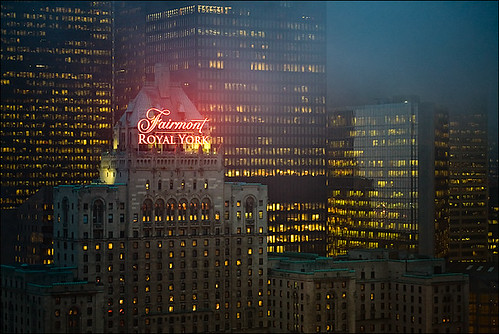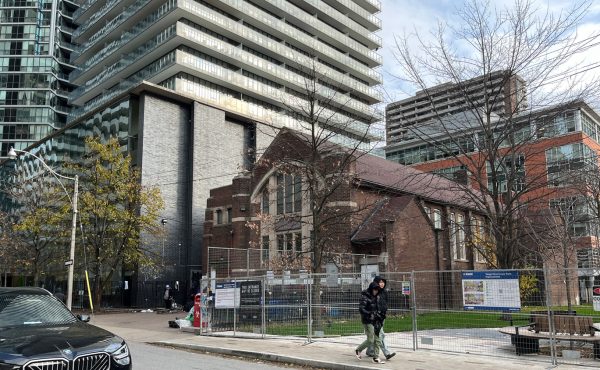

Every Thursday, Spacing will bring you a snapshot of Toronto’s past, looking into what took place that day in the city’s history. Throwback Thursday will address how the city has evolved, with an emphasis on issues that remain relevant for development in Toronto today.
– – – – – – – – – – – – – – – – –
Toronto’s skyline was never the same 80 years ago today. On June 11th, 1929 the chateau-style hotel formerly known as the Royal York Hotel opened its doors at 100 Front Street West as the tallest building not only in Toronto but in the entire British Empire.
The third hotel to occupy the site, the Canadian Pacific Railway demolished the former Queen’s Hotel to make way for the 28-story Royal York Hotel, whose final building cost was $16 million. At the time the hotel was considered to be state-of-the-art, complete with a radio, phone and a shower or bath in every one of its 1,048 rooms.

Not only private rooms filled the massive hotel; public rooms took up 1.5 acres of space and included a 12-bed hospital, a 12,000 book library, a 66 foot long telephone switchboard manned by 35 operators and a Concert Hall with a 50 tonne Casavant Frere pipe organ where the Canadian Opera Company put on its first production.
The Royal York was also one of the first buildings in Canada to have elevators, ten ornately decorated lifts that people would travel to Toronto just to ride in. The Hotel even had an early manifestation of a green roof with a glass-enclosed roof garden whose produce are used by the Hotel’s chefs capping the skyscraper.
The building was designed by Ross and Macdonald, based in Montreal, who were arguably Canada’s most famous architecture firm at the time while being assisted by Toronto’s own Sproatt and Rolph. Ross and Macdonald had also designed the newly built Union Station, which sat across the street from the Royal York.

In many ways, the hotel is truly “a city within a city block.” Having welcomed more than 40 million clients to its halls, it also boasts Canada’s largest kitchen (supposedly it can fit seven over three floors, equal to the size of three 747 jumbo jet interiors), a bakery that can make 15,000 rolls a day, three rooftop beehives providing up to 700 pounds of honey a year, five restaurants, four lounges including Toronto’s smallest bar – “York Station” – not to mention Toronto’s largest laundry, a health club and a spa. Complete with countless eccentricities and hidden gems, the building incites exploration.
Resident ghosts are one of many of the Royal York’s quirks. A grey-haired man in slacks and a burgundy smoking jacket is known to haunt the 8th floor. Similarly, a permanently closed Crystal Ballroom occupying one of the upper floors has been the cause for many noise complaints amongst hotel guests. Closed long ago because it didn’t meet modern fire code requirements, guests have been known to hear music, loud talking and shaking chandeliers coming from the floor.

In 1949, the Royal York became a field hospital after the cruise ship SS Noronic caught fire in the Toronto harbour directly across from the hotel. The hotel expanded in 1959, adding a 17-story east wing that provided an additional 400 rooms, making it the biggest hotel in the British Commonwealth. In the 1980s and 1990s, over $100 million was spent in renovating the hotel back to its 1920s splendor.
Photos from Wikimedia, wvs, the Toronto Archives (Fonds 1231, Item 1116),




13 comments
Very interesting. But there are buildings older than that which had and have elevators – maybe the FRY had the first in the country without operators.
And the 747 thing sounds off – maybe the interior space of seven 747s or something.
Isn’t the Crystal Ballroom in the King Eddy?
Two things (feel free to delete this comment!): “…a bakery that can make 15,000 roles a day…””…adding a 17-story east with that provided…”
I am always surprised by the number of ballrooms in this city that sit unused thanks to the modern fire code or other (usually lamer) reasons. It is hard to believe that property owners wouldn’t want to renovate them back into usefulness, but I suppose they don’t expect to recoup the investment in rental fees…
Another interesting quirk I remember reading about somewhere (the Star, I think):
There apparently are (or used to be) signs posted for employees, saying something to the effect of “One Flight Up, Two Flights Down”. The idea was to encourage staff to use the stairs when traveling up one floor or down one/two floors, to speed up service on the elevators.
(Sometimes I think my office building could use some of those signs.)
It may be correct to write that the RYH was the first to have ‘elevators’ (plural) but I believe the single elevator in the Gooderham Building (Flatiron) was in place long before 1929.
“The Royal York was also the first building in Canada to have elevators….”
Winnipeg (which, rumour has it, lies within Canada)has many pre-1929 buildings with elevators and Toronto no doubt did too.
“THE RYAN BUILDING
Ryan’s original building on Main St just south of the old city hall was a landmark but was demolished in the 1930s. It was the first stone building in Winnipeg and had the first electric passenger elevator installed a decade later. His second building located at 104 King St. was built in 1895.”
Elevators-plural existed before the Royal York: extant Yonge + King zone examples such as Traders Bank stand as proof of that.
Huh? The New York Life Insurance Building in Montreal was erected in 1887-1888 and came with the most modern of conveniences: an elevator that took you up to the absolutely dizzying height of 8 whole storeys! See http://www2.canada.com/components/print.aspx?id=199c1c3e-af3b-4bcf-a949-9b8f88c5c671
I think I read that the Royal York’s predecessor, the Queen’s Hotel, was the first hotel (if not the first building) in Canada with an elevator.
Hi everyone,
Greg, thanks for the editing. And point well taken on the elevator mistake.
Sean, there is a Crystal Ballroom in both the Royal York and the King Eddy. Most people have heard of the one in the King Eddy rather than the one in the Royal York.
King Eddy Crystal Ballroom: http://invisiblethreads.com/potd/collections/2004_keh/index.php
Royal York Crystal Ballroom: http://ghosts-hauntings.suite101.com/article.cfm/haunted_royal_york_hotel
Great piece. Loved the pictures.
Not sure where I read this story…
Legend has it that a member of the Czar’s family had travelled all over North America with her husband looking for a new home after being exiled.
Emerging from Union Station and seeing the Royal York for the first time, but not realizing it was a hotel, exclaimed that “this was finally a home worthy of our position.”
I visited Chicago a few weeks ago and one of their Intercontinental Hotels offers a tour of the architectural details — a swimming pool on the 7th floor, old mosaic ceilings, ballrooms, etc. It’s an audio-guided tour that they hand out on little iPod shuffles (in exchange for your ID and a credit card).
It was great, and I couldn’t help but think that there’s many old buildings in Toronto that could do the same. The Royal York would be a great place to do it! Lots of gorgeous history to show off.